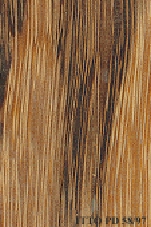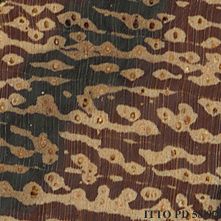
BOIS SERPENT (Marmaroxylon racemosum)
Trade Name
Bois serpent
Scientific Name
Marmaroxylon racemosum (Ducke) Killip ex Record
Family
LEGUMINOSAE
Common Names
Sinekioudou (French Guiana); Boesi (Surinam); Urubuzeiro (Brazil); Ingarana (Brazil); Angelim-Pedra-Verdadeiro (Brazil); Angelim-Aroeira (Brazil); Angelim (Brazil); Snefi-Oedoe (Surinam); Bostamarinde (Surinam); Bois Serpent (French Guiana); Snakewood (Guyana); Ingarana Da Terra Firme (Brazil); Forest Tamarind; Angelim Rajado (Brazil); Marblewood
Scientific Name Synonyms
Pithecellobium racemosum Ducke
Description Of The Tree
Botanical Description
The size of the mature tree is reported to be small with total lengths often between 15 to 20 m, and diameters of about 40 to 50 cm up to 70 cm. It presents small buttresses.
Natural Habitat
Marmaroxylon racemosum is found in primary and old secondary forests, growing on well drained sites.
Natural Distribution
The species is reported to be distributed in the Amazon basin, Guyana, and Surinam.
Wood Identification
Anatomic Description Of Wood
Wood diffuse porous. Vessels solitary and in short radial multiples. Tangential diameter of vessel lumina 150 to 200 micras (medium). Occasionally vessels with colored deposits. Vessels per mm2 less than 6 (rare). Simple perforation plates. Vessel-ray pits simi Axial parenchyma apparent with the naked eye. Occasionally axial parenchyma in marginal or in seemingly marginal bands. Axial parenchyma lozenge-aliform. Axial parenchyma aliform. Axial parenchyma confluent. Prismatic crystals in non-chambered axial parenchyma Rays more than 10 per mm (abundant). Rays 1 to 2 seriate. Homogeneous rays and/or sub-homogeneous rays (all ray cells procumbent). Fibers with simple to minutely bordered pits.
-
 Wood Macro Photo Tangential Plane
Wood Macro Photo Tangential Plane
-
 Wood Micro Photo Of Transversal Section
Wood Micro Photo Of Transversal Section
Availability
Cites Status
Unrestricted
General Wood Description
Odor
The wood has no specific odor or taste.
Color
The color of the heartwood is described as yellow beige with dark maroon veins, irregularly wide and spaced.
COLOR INDEX (1=Black, 7=Light yellow,white)
4
Grain
The grain is typically straight, sometimes wavy or interlocked
Texture
Texture is usually medium to coarse.
Luster
This wood is commonly of low luster.
Natural Durability
It has moderate resistance to decay. Its resistance to attack by termites and dry wood insects is rated as good.
Natural durability index (1= Very high durability, 7=Vey low durability)
3
Resistance To Impregnation
Response to preservative treatment is reported to be poor.
Wood Physical Properties
Basic Density or Specific Gravity (O.D. weight/vol. green) (g/cm³)
0.87
Air-dry Density (Weight and volume at 12%MC) (g/cm³)
1.01
Total shrinkage Tangential (Saturated to 0%MC) (%)
10.5
Total shrinkage Radial (Saturated to 0%MC) (%)
6.0
Drying Defects
Ease of Drying: Air seasoning is reported to be moderate. Drying Defects: Slight risk of checking and cupping. Casehardening is also reported.
Dimensional stability ratio (Total Tangential Shrinkage %/Total Radial Shrinkage %)
1.8
Wood Chemical Properties
Wood Mechanical Properties
Bending Strength (MOR),12%MC (kgf/cm²)
1537
Stiffness (MOE) 12%MC (kgf/cm²)
218066
Compression parallel to fiber 12%MC (kgf/cm²)
761
Workability
Sawing
Sawmilling of this species is reportedly difficult.
Rotary Veneer Cutting
M. racemosum slicing is interesting for decorative veneer.
Sliced Veneer
M. racemosum slicing is interesting for decorative veneer.
Blunting Effect
Dulling effect on cutting edges is reported to be moderate, special tools are recommended.
Machining
Machining is reported to be difficult because of its hardness. Interlocked grain may also affect machining, and specially tipped cutters are recommended.
Planing
Planing is reported to be difficult.
Turning
30
Nailing
The wood is very hard and heavy, difficult to nail and requires pre-boring.
Gluing
Gluing properties are rated as generally good. Special care recommended.
Finishing
Finishing operations are rated as good to fair.
REFERENCED USES
End Uses Summary
HOUSING GENERAL, flooring, steps, panelling, FURNITURE AND CABINETS, cabinets, TURNING
General Housing
- 10 - Silica in Timbers
Flooring
- 14 - Handbook of Hardwoods
Steps
- 17 - Tree Conservation Database
Paneling
- 18 - W3TROPICOS Missouri Botanical Garden
Furniture Cabinets
- 21 - Tropical timbers of the world. Part III-Southeast Asian and Oceanian Species.
Cabinet
- 24 - Empire Timbers
Turning
- 30 - Embassy of Honduras in Japan
Please Provide Information To View Producer Information